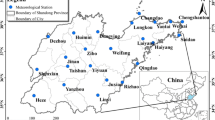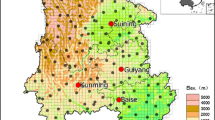Abstract
Global increases in duration and prevalence of droughts require detailed drought characterization at various spatial and temporal scales. In this study, drought severity in **njiang, China was investigated between 1961 and 2012. Using meteorological data from 55 weather stations, the UNEP (1993) index (I A), Erinç’s aridity index (I m), and Sahin’s aridity index (I sh) were calculated at the monthly and annual timescales and compared to the Penman-Monteith based standard precipitation evapotranspiration index (SPEIPM). Drought spatiotemporal variability was analyzed for north (NX), south (SX), and entire **njiang (EX). I m could not be calculated at 51 stations in winter as T max was below 0. At the monthly timescale, I A, I m, and I sh correlated poorly to SPEIPM because of seasonality and temporal variability, but annual I A, I m, and I sh correlated well with SPEIPM. Annual I A, I m, and I sh showed strong spatial variability. The 15 extreme droughts denoted by monthly SPEIPM occurred in NX but out of phase in SX. Annual precipitation, maximum temperature, and relative and specific humidity increased, while air pressure and potential evapotranspiration decreased over 1961–2012. The resulting increases in the four drought indices indicated that drought severity in **njiang decreased, because the local climate became warmer and wetter.












Similar content being viewed by others
Abbreviations
- I A :
-
UNEP aridity index
- e a :
-
Vapor pressure of air
- I m :
-
Erinç’s aridity index
- I sh :
-
Sahin’s aridity index
- LTA:
-
Long-term average
- M :
-
Multi-year mean
- P :
-
Precipitation
- PR:
-
Air pressure
- RH:
-
Relative humidity
- S h :
-
Specific humidity
- ETo :
-
Potential evapotranspiration
- SPI:
-
Standardized precipitation index
- SPEI:
-
Standardized precipitation evapotranspiration index
- U 2 :
-
Wind speed at 2 m
- n :
-
Sunshine hour
- T min :
-
Minimum air temperature
- T max :
-
Maximum air temperature
- T a :
-
Mean air temperature
- C v :
-
Variability coefficient
- C v, t :
-
Temporal C v
- C v, s :
-
Spatial C v
References
Alam M-T, Iskander S-M (2013) Climate change impact: climate type, vegetation type, rainfall intensity over three decades in Bangladesh. IOSR J Environ Sci Toxicol Food Technol 4(6):56–59
Allen RG, Pereira LS, Raes D, Smith M (1998) Crop evapotranspiration: guidelines for computing crop requirements, irrigation and drainage paper 56. FAO, Roma
Altin TB, Barak B, Altin BN (2012) Change in precipitation and temperature amounts over three decades in Central Anatolia, Turkey. Atmos Clim Sci 2:107–125
Arora VK (2002) The use of the aridity index to assess climate change effect on annual runoff. J Hydrol 265(1–4):164–177
Bacanli UG, Dikbas F, Baran T (2011) Meteorological drought analysis case study: Central Anatolia. Desalin Water Treat 26(1–3):14–23. doi:10.5004/dwt.2011.2105
Bates BC, Kundzewicz ZW, Wu S, Palutikof JP (Eds.) (2008) Climate change and water. Technical Paper, International Panel on Climate Change (IPCC) Secretariat, Geneva
Beguería S, Vicente-Serrano SM, Angulo M (2010) A multi-scalar global drought data set: the SPEI base: a new gridded product for the analysis of drought variability and impacts. Bull Am Meteorol Soc 91:1351–1354
Beguería S, Vicente-Serrano SM, Reig F, Latorre B (2013) Standardized precipitation evapotranspiration index (SPEI) revisited: parameter fitting, evapotranspiration models, tools, datasets and drought monitoring. Int J Climatol. doi:10.1002/joc.3887
Blaney HF, Criddle WD (1950) Determining water requirements in irrigated areas from climatologically and irrigation data. USDA, SCS. SCS-TP-96, 48
Bloomfield JP, Marchant B (2013) Analysis of groundwater drought using a variant of the Standardised Precipitation Index. Hydrol Earth Syst Sci Discuss 10:7537–7574
Budyko MI (1974) Climate and life. Academic, Orlando, p 508
China Meteorology Administration (2006) Classification of meteorological drought. GB/T 20481–2006. China Meteorological Press, Bei**g, In Chinese
Erinç S (1965) An attempt on precipitation efficiency and a new index. Istanbul University Institute Release. Baha Press, Istanbul (in Turkish)
Geng Q, Wu P, Zhao X, Wang Y (2014) Comparison of classification methods for the divisions of wet/dry climate regions in Northwest China. Int J Climatol 34:2163–2174
Gill AE (1982) Atmosphere–ocean dynamics. Academic, New York
Guttman NB (1998) Comparing the palmer drought index and the standardized precipitation index. J Am Water Resour Assoc 34:113–121
Haider S, Adnan S (2014) Classification and assessment of aridity over Pakistan provinces (1960–2009). Int J Environ 3(4):24–35
Hargreaves GH, Samani ZA (1985) Reference crop evapotranspiration from temperature. Appl Eng Agric 1:96–99
Held IM, Soden BJ (2000) Water vapor feedback and global warming. Annu Rev Energy Environ 25:441–475
Huo Z, Dai X, Feng S, Kang S, Huang G (2013) Effect of climate change on reference evapotranspiration and aridity index in arid region of China. J Hydrol 492:24–34
Kao SC, Govindaraju RS (2010) A copula-based joint deficit index for droughts. J Hydrol 380(1–2):121–134
Kendall MG (1975) Rank auto-correlation methods. Charles Griffin, London
Li Y, Zhou MD (2014) Trends in dryness index based on potential evapotranspiration and precipitation over 1961–2099 in **njiang, China. Adv Meteorol 2014:1–15. doi:10.1155/2014/548230
Li B, Liang Z, Yu Z, Acharya K (2014) Evaluation of drought and wetness episodes in a cold region (Northeast China) since 1898 with different drought indices. Nat Hazards 71:2063–2085
Mann HB (1945) Non-parametric tests against trend. Econometrica 13:245–259
Mao WY, Nan QH, Shi HZ (2008) Research of climatic regionalization with climate change in **njiang. Meteorol Monthly 34(10):67–73 (in Chinese)
McKee TB, Doeskin NJ, Kleist J (1993) The relationship of drought frequency and duration to time scales. In: Proceedings of the 8th Conference on Applied Climatology, January 17–22, Anaheim, CA, Am Meteor Soc 179–184
Mishra AK, Singh VP (2010) A review of drought concepts. J Hydrol 391:202–216
Nielsen DR, Bouma J (1985) Soil spatial variability. In: Proceedings of a Workshop of the International Soil Science Society and the Soil Science Society of America, Pudoc, Wageningen. pp. 243
Núñez J, Rivera D, Oyarzún R, Arumí JL (2014) On the use of standardized drought indices under decadal climate variability: critical assessment and drought policy implications. J Hydrol 517:458–470
Palmer WC (1965) Meteorological drought: U.S. Weather Bureau Research Paper, 45, 64 pp
Palmer WC (1968) Kee** track of crop moisture conditions, nationwide: the new crop moisture index. Weatherwise 21:156–161
Priestley CHB, Taylor RJ (1972) On the assessment of surface heat flux and evaporation using large-scale parameters. Mon Weather Rev 100(2):81–92
Ruckstuhl C, Philipona R, Morland J, Ohmura A (2007) Observed relationship between surface specific humidity, integrated water vapor, and longwave downward radiation at different altitudes. J Geophys Res 112, D03302. doi:10.1029/2006JD007850
Sadeghi AR, Kamgar-Haghighi AA, Sepaskhah AR, Khalili D, Zand-Parsa SH (2002) Regional classification for dryland agriculture in southern Iran. J Arid Environ 50:333–341
Sahin S (2012) An aridity index defined by precipitation and specific humidity. J Hydrol 444–445:166–208
Sen PK (1968) Estimates of the regression coefficient based on Kendall’s tau. J Am Stat Assoc 63:1379–1389
Sheffield J, Wood EF, Roderick ML (2012) Little change in global drought over the past 60 years. Nature 491:435–437
Shukla S, Wood AW (2008) Use of a standardized runoff index for characterizing hydrologic drought. Geophys Res Lett 35, L02405. doi:10.1029/2007GL032487
Staudinger M, Stahl K, Seibert J (2014) A drought index accounting for snow. Water Resour Res 50:7861–7872. doi:10.1002/2013WR015143
Thornthwaite CW (1948) An approach toward a rational classification of climate. Geogr Rev 38:55–94
Türkeş M, Akgündüz AS (2011) Assessment of the desertification vulnerability of the Cappadocian district (Central Anatolia, Turkey) based on aridity and climate-process system. Int J Human Sci 8(1):1234–1268
UNEP (1993) World atlas of desertification. The United Nations Environment Programme (UNEP). London
Vicente-Serrano SM, Beguería S, López-Moreno JI (2010) A multiscalar drought index sensitive to global warming: the standardized precipitation evapotranspiration index. J Clim 23:1696–1718
Vicente-Serrano SM, Azorin-Molina C, Sanchez-Lorenzo A, Moran-Tejeda E, Lorenzo-Lacruz J, Revuelto J, López-Moreno JI, Espejo F (2014) Temporal evolution of surface humidity in Spain: recent trends and possible physical mechanisms. Clim Dyn 42:2655–2674
Wang B, Zhang M, Wei J, Wang S, Li S, Ma Q, Li X, Pan S (2013) Changes in extreme events of temperature and precipitation over **njiang, northwest China, during 1960–2009. Quat Int 298:141–151
Wen KG, Shi YG (2006) China's meteorological disaster: volume of **njiang. China Meteorological Press, Bei**g, p 340, in Chinese
Yue S, Pilon P, Phinney B, Cavadias G (2002) The influence of autocorrelation on the ability to detect trend in hydrological series. Hydrol Process 16:1807–1829
Zhang Q, Li JF, Singh VP, Bai YG (2012) SPI-based evaluation of drought events in **njiang, China. Nat Hazards 64(1):481–492
Zuo HC, Lu SH, Hu YQ (2004) Variation of trend of yearly mean air temperature and precipitation in China in the last 50 years. Plateau Meteol 23(2):238–244 (in Chinese)
Acknowledgments
This study was financially supported by the **njiang Joint Project of the Chinese National Science Foundations (U1203182, 51579213), the State Foundation for Studying Abroad (201506305014), and China 111 project (B12007). We also thank the Meteorological Data Sharing Service Network in China (cdc.nmic.cn) for supplying weather data. The constructive comments of three anonymous reviewers strengthened the analyses of this paper.
Author information
Authors and Affiliations
Corresponding author
Rights and permissions
About this article
Cite this article
Li, Y., Yao, N., Sahin, S. et al. Spatiotemporal variability of four precipitation-based drought indices in **njiang, China. Theor Appl Climatol 129, 1017–1034 (2017). https://doi.org/10.1007/s00704-016-1827-5
Received:
Accepted:
Published:
Issue Date:
DOI: https://doi.org/10.1007/s00704-016-1827-5




